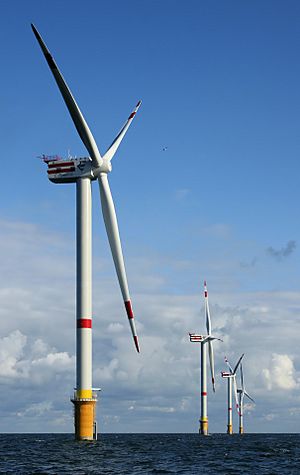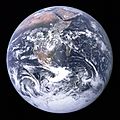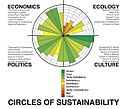Sustainable development facts for kids
Sustainable development is about meeting our needs today without stopping future generations from meeting their own needs. It means using resources wisely so they don't run out. Imagine you want to eat a cookie, but you also want your younger sibling to have one tomorrow. Sustainable development is like making sure there are enough cookies for everyone, now and later!
This idea helps us think about how we live and how our actions affect the planet and other people. It's about making sure everyone has a good quality of life, both now and in the future.
Contents
What Does Sustainable Development Mean?
Sustainable development helps us create a better world for everyone. It looks at three main areas that are all connected:
A Healthy Environment
This means keeping our planet clean and healthy. It includes having green spaces, clean air, and clean water. We want to reduce pollution and noise. It also means using resources like water and trees in a way that they can renew themselves. This way, there will be enough for future generations.
A Strong Economy
A strong economy means people have good jobs and can afford what they need. It also means fair prices for things like food and energy. When the economy is strong, communities can grow and improve.
Good Social Conditions
This part is about making sure everyone in a community feels safe and happy. It includes having good places for fun, like parks and sports centers. It also means people get along and help each other. Good schools and health care are also important for social well-being.
These three parts are linked. For example, if there are no jobs (economy), crime might go up (social). If there's a lot of pollution (environment), people might get sick (social). Sustainable development tries to fix all these problems together.
Why is Sustainable Development Important?
Sustainable development helps us solve big problems around the world. It's not just about one country or one neighborhood. It's a global effort to make sure everyone has what they need to live well.
This includes:
- Having a safe home.
- Getting a good job.
- Access to education for children.
- Good health care.
- Living in a safe and healthy community.
Even in rich countries, many people still face challenges. They might live in poverty or in poor homes. Their quality of life can be affected by crime or pollution. Sustainable development aims to improve life for everyone.
Many communities have plans to become more sustainable. These plans often follow ideas from an international agreement called Agenda 21. This plan was created at a big meeting called the United Nations Earth Summit in 1992. It helps local groups work towards a better future.
Other pages
Images for kids
-
The The Blue Marble photograph, taken from Apollo 17 in 1972, became a symbol for protecting our environment.
-
This graph shows the connection between how much we use resources (our ecological footprint) and how well people live (Human Development Index).
-
A sewage treatment plant in Majorca that uses solar energy to clean water.
-
Deforestation in the Amazon rainforest is a concern because it harms nature and reduces biodiversity.
-
Deforestation of native rain forest in Rio de Janeiro City to get clay for building (2009 picture).
See also
 In Spanish: Desarrollo sostenible para niños
In Spanish: Desarrollo sostenible para niños









